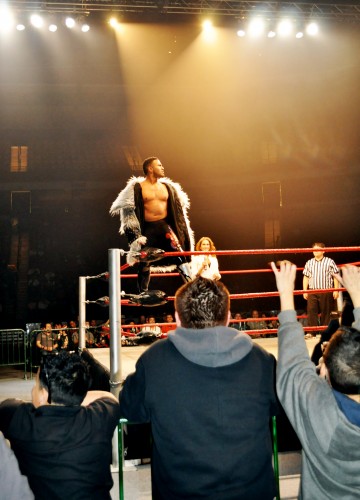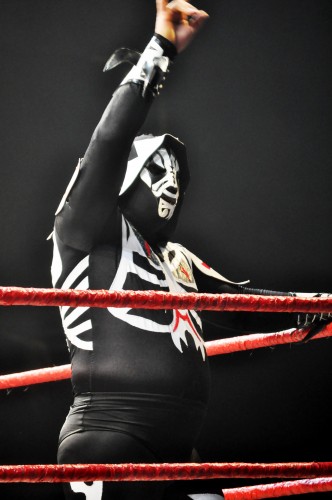by Paige Wiren
Straight up, I’m a gringa. I grew up in Anglo country club culture and know little about Latino culture save for the few things co-opted by Anglos, like Mexican cuisine, piñatas and Cinco de Mayo. But, being a curious gringa, I was intrigued by the thought of experiencing the recent Lucha Libre event hosted by West Valley City’s Maverik Center on a Sunday night in February.
Stated on their website, the mission of event promoter Lucha Libre USA is to “introduce Americans to the phenomenon” of the “art form” that in Mexico is second to soccer in popularity. Maverik box office manager Jeff Kooring shared that the center’s management staff has decided to serve the ever-increasing Latino demographic by hosting an events series, of which the Lucha Libre was the flagship engagement. It seems like a good fit since West Valley City has the largest Latino population in Salt Lake Valley. But how does a staff of gringos know how to even begin to get the word out to the ticket-purchasing community?
Enter into the ring, Enrique Sosa, West Valley City’s Hispanic Services Specialist, hired, according to WVC, to help “our growing Hispanic population integrate into life in the United States.” But wait. Hispanic? Latino? What, I asked Enrique, is the difference? “Historically, people from the Iberian Peninsula were Hispanic, and Latino was the term used for Latin American people. The US government adopted the word Hispanic to refer to anyone who speaks Spanish, but if you ask the people here they will say they are Latino, or Mexicano, not Hispanic.”
Enrique worked with the Maverik staff to promote the event in local tiendas and on the radio, the strategic idea being that if people feel connected to their community by attending a familiar-feeling cultural event, the immediate community that sponsors the event will then feel like home. “If there’s a message that I would like the people to hear, it’s that the city is working hard to do something to help make people feel integrated.” The event represents the melting in the American pot, a Latino sensation introduced to Americans in America, but also presented for naturalized or un-naturalized Mexican Americans to help them make the cultural transition to their new adopted country. Sounds awfully political when the actual experience is to wildly cheer on audacious, brawny men dressed in over-the-top, Halloween-like costumes performing choreographed theatrical acrobatics.
Many fathers were taking their sons to their first Lucha Libre event. In fact, a large number of spirited attendees were children, giving the crowd a Ringling rather than a hardcore ringside feel to it. Occasional diehard fans wore wrestler, or luchador, masks. The Anglo girlfriend of one masked Mexican fan interpreted for me saying that her boyfriend has about 50 different masks. Lucha Libre enthusiasts drove from counties both north and south of Salt Lake to root for luchadores who enjoy celebrity status in the sport’s country of origin. For sure, the minority spectator was the local white guy who had been watching all different forms of professional wrestling on TV since he was a kid and whose wife had bought them tickets for a Valentine’s present. The more common Anglo spectator there was like the Bountiful web designer and his buddies who work for Maverik Inc. and were comped tickets for the event. The predominantly Latino crowd had seen Lucha Libre before, when they lived in Mexico, and knew what to expect when the lights dimmed and the smoke machine started pumping white puffs across the strobe light entrance where the wrestlers made their dramatic entrance.
Lucha libre is sports entertainment. Agile contenders like Super Nova, Charly Malice and American professional wrestler-turned-luchador, Marco Corleone, delight the crowd with their adversarial drama. “Good guys,” or technicos, fight against rudos, the “bad guys.” The Luchadores play to the crowd, strutting and posing before then taunting and provoking their opponent with classic, exaggerated smack talk. Or not. Some rivals explode into the ring, diving from atop the ropes, performing gymnastic combative aerial feats that, if ill-calculated, could result in actual injury like that simulated by the performers’ affected brawling. In between matches vendors sell standard arena sweet treats and the emcee satisfies the crowd’s hunger with Lucha Libre giveaways. The crowd cheers on their favorites in singles, tag team and the final battle royal match in which all luchadores vie for the last man standing prize.
Although not a sell-out event, I think that with the combined efforts of the Maverik Center and Enrique Sosa, the next Lucha Libre contest could reach the larger target audience, to include gringas like myself who gratefully enjoyed the animated night of good, clean fun.
Have the issue delivered to your home for just $3.80 (including tax and delivery).

